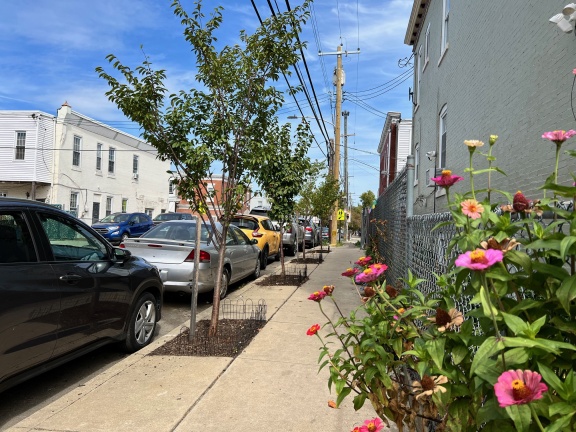
Background
Healthy trees make a significant contribution to the quality of life of Philadelphia residents. Trees provide protection from heat, reduce air pollution, improve physical and mental health, and are an important asset for mitigating climate change and adapting to its impacts. Given these benefits, it is especially unfortunate that trees are not equitably distributed across the city, and that the urban forest is threatened by development, inadequate maintenance, and the effects of climate change.
A comprehensive assessment of Philadelphia’s tree canopy conducted in 2018 found that 6% of the city’s tree canopy (the part of the land that is covered by tree leaves and branches from a bird’s-eye view) was lost over the last decade. The assessment also illustrates the inequitable distribution of trees. Tree canopy covers 20% of all land across the city, but this ranges from less than 5% in some areas to more than 45% in others. Areas with fewer trees and less tree canopy tend to be lower-income and Black and Brown-majority neighborhoods that are also beset by other inequities. The quality-of-life implications can be profound, as these areas often experience higher temperatures – sometimes up to a 22-degree disparity – and have worse physical and mental health outcomes.
In response to these findings, the City launched a process to develop its first-ever strategic plan to make tree coverage more robust, equitable, and sustainable. Released in 2023 and informed by input from more than 9,000 residents, the Philly Tree Plan established a 10-year strategy for the equitable growth and care of Philadelphia’s urban forest. Based on key environmental and socioeconomic factors, the Philly Tree Plan identified seven areas where an increase in tree canopy can provide the most benefit and recommends prioritizing these areas for investments to grow and care for the urban forest.
Opportunity Overview
The Foundation seeks to support efforts that will help to grow and sustain Philadelphia’s urban forest.
Organizations that propose projects in partnership with other applicants will be considered on their individual merits. However, the Foundation recognizes that making significant progress on the objective is difficult and encourages organizations to include partnerships that leverage complementary strengths, resources, and expertise to reach proposed goals.
As noted above, proposals may focus on a small geographic area or seek to make change on a citywide scale, provided they demonstrate impact in one or more of the Philly Tree Plan’s priority areas. To navigate to the Philly Tree Plan’s Priority Areas, please use this map. Please note: the map defaults to a different layer, so it is important that you turn on the correct layer to view the Priority Areas relevant to this opportunity. Refer to the screenshot here for instructions on how to select the correct layer. All proposals that meet the criteria described in the Review Criteria section below are encouraged.
The Foundation recognizes that multiple strategies can contribute to increasing the number of trees in Philadelphia by 2035, and we welcome a wide range of approaches in response to this RFP. This includes, but is not limited to, proposals that focus on:
- Tree planting and establishment care, including along streets and in parks and private yards;
- Reducing physical, economic, and social barriers to new trees and increasing community trust;
- Expanding the capacity to plant and care for trees through workforce development and volunteer engagement;
- Advocating for policy or funding changes that increase tree planting and establishment care citywide, with significant impact in priority areas;
While this RFP invites proposals that support activity in addition to tree planting, as these examples indicate, all proposals should articulate a clear connection between the proposed activities and the Foundation’s objective of adding 35,000 trees in priority areas of the Philly Tree Plan by 2035.
In describing the proposed work, all submitted proposals should, as applicable:
- Identify the priority area(s) where the proposed work will take place or have an impact. Please specify the neighborhood(s) and/or include a map showing the anticipated project location(s).
- Articulate how the proposed work seeks to advance or complement up to three specific goal(s) (e.g., goal 1) or subgoal(s) (e.g., goal 1.2) of the Philly Tree Plan.
- Project (to the maximum extent possible) the number of trees that will be planted because of the work, and the anticipated timeframe.
We are requesting proposals for up to three years of funding. After reviewing proposals, WPF will conduct site visits and gather additional information from a limited number of organizations. WPF has $2.5 million available to advance this objective through this RFP.
WPF values diverse approaches from various organizations and communities to address the objective, and we aim to attract and fund a range of projects – including those led by smaller organizations and by people who have historically faced discrimination or exclusion. There is no minimum or maximum amount of funding that projects may request. The grant amount requested should be commensurate with the contribution that the project will make to the overall objective.
Full Request for Proposals (RFP) and Application
Download the full RFP packet for more information about this opportunity including eligibility, review criteria, learning and insights, budget, and link to an application template.
All applications must be submitted through the Grants Portal.
Webinar
An informational webinar was held on Monday, September 15, 2025: